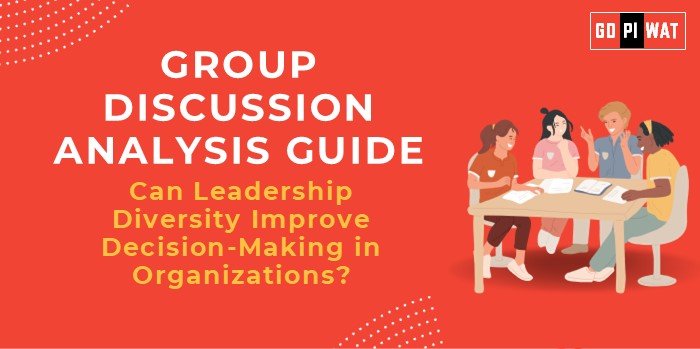📋 Can Leadership Diversity Improve Decision-Making in Organizations?
🌐 Group Discussion (GD) Analysis Guide
🌟 Introduction to Leadership Diversity in Organizations
Opening Context: Leadership diversity has become a crucial topic for organizations striving to adapt to globalization, innovation, and inclusivity. Studies suggest diverse teams outperform homogeneous ones in complex decision-making.
Topic Background: Leadership diversity refers to a mix of gender, ethnicity, age, cultural backgrounds, and experiences in leadership positions. It aligns with the need for ethical practices, equity, and better business performance.
📊 Quick Facts and Key Statistics
- 📈 McKinsey Report 2023: Companies in the top quartile for gender diversity are 25% more likely to outperform financially.
- 💰 Board Diversity Impact: 19% improvement in ROI reported when boards have diverse leadership.
- 👩💼 Global Women in Leadership (2023): Women hold only 28% of managerial positions worldwide (ILO).
- 💡 Innovation Boost: 63% of executives believe diversity improves innovation and competitiveness.
👥 Stakeholders and Their Roles
- 🏢 Organizations: Implement policies promoting diversity at leadership levels.
- 🏛️ Governments: Create regulatory frameworks encouraging leadership inclusion.
- 👩💻 Employees: Benefit from equitable representation and career opportunities.
- 📈 Shareholders/Investors: Gain better returns due to improved decision-making.
🏆 Achievements and Challenges
🌟 Achievements
- 📊 Improved Financial Performance: Gender-diverse companies achieve higher revenue growth.
- 💡 Enhanced Decision-Making: Diverse leadership brings multiple perspectives to solve problems.
- 😊 Positive Work Culture: Inclusivity leads to higher employee satisfaction and retention.
⚠️ Challenges
- 🔍 Tokenism: Superficial inclusion without real empowerment.
- 📉 Resistance to Change: Legacy systems and unconscious biases hinder progress.
- 📊 Lack of Representation: Women and minorities remain underrepresented in top positions globally.
🌍 Global Comparisons
- 🇳🇴 Norway: Legislation mandates 40% women on corporate boards, fostering diversity.
- 🇺🇸 US: Companies like Google and Microsoft implement inclusive hiring and leadership programs.
📖 Case Studies
📝 PepsiCo: Indra Nooyi’s leadership highlights the success of diverse leadership for growth and innovation.
🗣️ Structured Arguments for Discussion
- ✅ Supporting Stance: “Leadership diversity fosters innovation and improves decision-making by integrating diverse viewpoints.”
- ❌ Opposing Stance: “Diversity in leadership might slow decision-making due to conflicting opinions.”
- ⚖️ Balanced Perspective: “While leadership diversity brings challenges, its long-term benefits for decision-making and performance outweigh short-term hurdles.”
💡 Effective Discussion Approaches
📌 Opening Approaches
- 📊 Statistical Start: “According to McKinsey, companies with diverse teams outperform by 25%.”
- 📖 Case Study Lead: “The success of PepsiCo under Indra Nooyi showcases how diverse leadership improves performance.”
↔️ Counter-Argument Handling
- 💬 Challenge: “Diverse teams can face disagreements.”
- 🔄 Response: “Disagreements, when managed well, lead to thorough and innovative solutions.”
📋 Strategic Analysis of Strengths and Weaknesses
📊 SWOT Analysis
- 💪 Strengths: Improves innovation, financial performance, and decision-making quality.
- ⚠️ Weaknesses: Initial resistance, token representation, potential communication gaps.
- 🌟 Opportunities: Leveraging diversity for global competitiveness and inclusivity.
- 🚧 Threats: Bias in promotions, reluctance to adopt inclusive leadership models.
🎓 Connecting with B-School Applications
- 📂 Real-World Applications: Diversity management in operations, HR strategies, and business ethics projects.
- 💡 Sample Interview Questions:
- ❓ “How does leadership diversity improve decision-making in volatile markets?”
- ❓ “What steps can organizations take to ensure real empowerment through leadership diversity?”
- 📖 Insights for B-School Students: Understand diversity as a competitive edge and study leadership frameworks like inclusivity models or DEI (Diversity, Equity, Inclusion) strategies.


